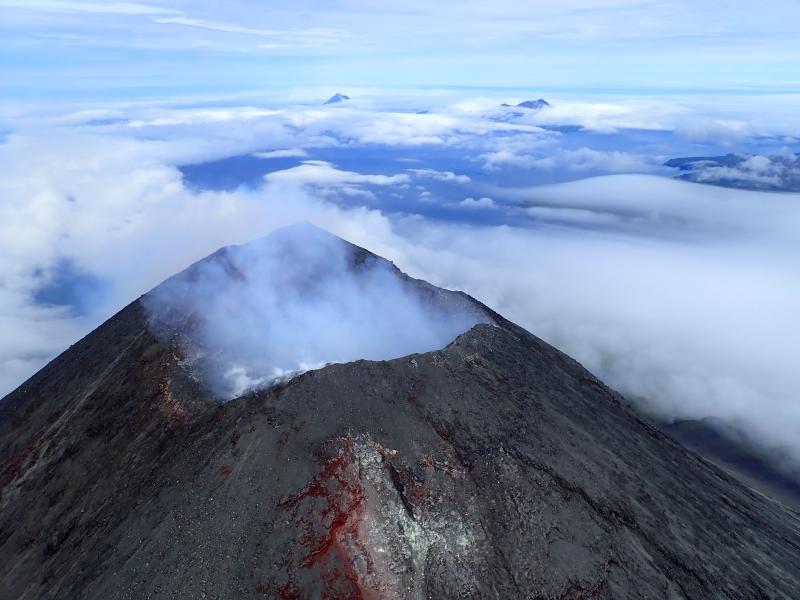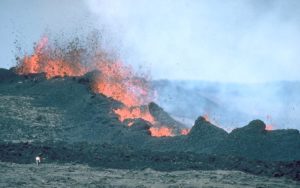
A large, potentially dangerous volcano isn’t erupting yet, but scientists say odds have increased of eruptive activity at the Cleveland Volcano. USGS scientists monitoring it have raised the Volcano Alert Level and Aviation Color Code to ADVISORY /YELLOW due to elevated surface temperatures and an increase in sulfur dioxide emissions.
This large stratovolcano, located in the Islands of Four Mountains group of the Aleutian chain in Alaska, is 5,676 feet tall and nearly perfectly symmetrical. One of the most active volcanoes in the Aleutian Arc, Cleveland has erupted at least 22 times in the last 230 years. Most recently Mount Cleveland has erupted three times in 2009, twice in 2010, once in 2011 and in 2016 and 2017. A small eruption occured on June 2 in 2020.
The volcano is monitored by the Alaska Volcano Observatory (AVO), which is a joint program of the U.S. Geological Survey (USGS), the Geophysical Institute of the University of Alaska Fairbanks (UAFGI), and the State of Alaska Division of Geological and Geophysical Surveys (ADGGS). The AVO is similar to the Hawaii Volcano Observatory (HVO) which monitors Hawaii’s three active volcanoes: Kilauea, Mauna Loa, and Hualalai. In the case of AVO, they monitor Cleveland, Semisopochnoi, and Veniaminof, all of which are under watch or advisory now. Alaska is home to many volcanoes, though; there are more than 130 volcanoes and volcanic fields which have been active within the geologically young last 2 million years. 50 have been active since the mid 1700s and AVO studies those too.

According to AVO, satellite detections of increased volcanic gas emissions and elevated surface temperatures were observed at Cleveland Volcano beginning on May 10. AVO cautions, “Episodes of lava effusion and explosions can occur without advance warning. Explosions from Cleveland are normally short duration and only present a hazard to aviation in the immediate vicinity of the volcano. Larger explosions that present a more widespread hazard to aviation are possible, but are less likely and occur less frequently.”
Aviation Codes are green, yellow, orange, or red. When ground-based instrumentation is insufficient to establish that a volcano is at a typical background level of activity, it is simply “unassigned.” While green means typical activity associated with a non-eruptive state, yellow means a volcano is exhibiting signs of elevated unrest above known background levels. When a volcano exhibits heightened or escalating unrest with the increased potential of eruption, it jumps to orange. Finally, when an eruption is imminent with significant emission of volcanic ash expected in the atmosphere or an eruption is underway with significant emission of volcanic ash into the atmosphere, the code becomes red.

Volcanic Activity Alert levels are normal, advisory, watch, or warning. As with aviation codes, if data is insufficient, it is simply labeled as “unassigned.” When the volcano is at typical background activity in a non-eruptive state, it is considered normal. If the volcano exhibits signs of elevated unrest above background level, an advisory like the one now in effect for Cleveland is issued. If a volcano exhibits heightened or escalating unrest, a watch is issued while a warning is issued when a hazardous eruption is imminent.
Explosions from Cleveland typically produce relatively small volcanic ash clouds that dissipate within hours; however, more significant ash emissions are possible, especially if the stratovolcano experiences a full eruption. Stratovolcanoes have relatively steep sides and are more cone-shaped than shield volcanoes. Unlike the more flat shield volcanoes found in Hawaii, in a stratovolcano like Cleveland, the lava builds up around the vent forming a volcano with steep sides. Stratovolcanoes are more likely to produce explosive eruptions due to gas building up in the viscous magma inside